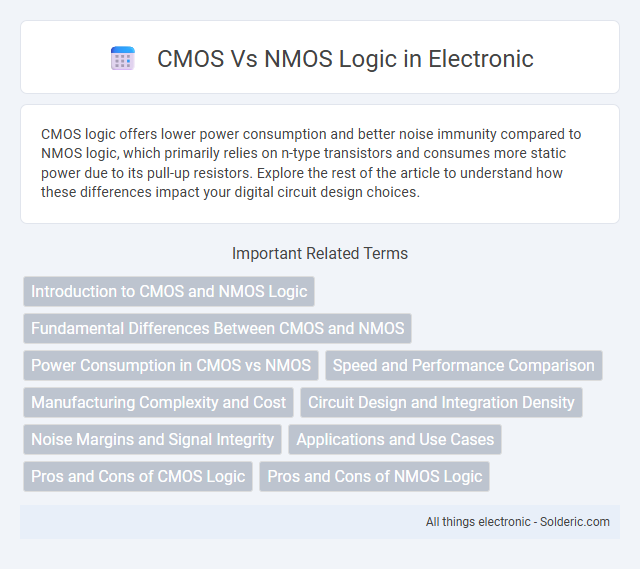CMOS logic offers lower power consumption and better noise immunity compared to NMOS logic, which primarily relies on n-type transistors and consumes more static power due to its pull-up resistors. Explore the rest of the article to understand how these differences impact your digital circuit design choices.
Comparison Table
| Feature | CMOS Logic | NMOS Logic |
|---|---|---|
| Technology | Complementary MOS (PMOS + NMOS) | Only NMOS Transistors |
| Power Consumption | Low static power, power only during switching | Higher static power, continuously draws current |
| Noise Margin | High noise immunity | Lower noise margins |
| Speed | Moderate to high speed | Generally faster switching |
| Voltage Swing | Full rail-to-rail output (0 to Vdd) | Reduced voltage swing |
| Complexity | More complex due to dual transistors | Simpler circuit design |
| Usage | Dominant in modern digital ICs | Used in older and simpler logic circuits |
Introduction to CMOS and NMOS Logic
CMOS logic utilizes both p-type and n-type MOSFETs to achieve low power consumption and high noise immunity, making it the dominant technology in modern digital circuits. NMOS logic relies solely on n-type MOSFETs, offering faster switching speeds but higher power dissipation due to static current flow. The complementary structure of CMOS enables efficient voltage transfer characteristics and minimal static power use compared to the single-type transistor design in NMOS logic.
Fundamental Differences Between CMOS and NMOS
CMOS logic uses both p-type and n-type MOSFETs to create complementary pull-up and pull-down networks, enabling low static power consumption and high noise margins. NMOS logic relies solely on n-type MOSFETs with resistive or depletion-mode loads, resulting in higher power dissipation and slower switching speeds. The fundamental difference lies in CMOS's ability to reduce power consumption by using complementary transistors, whereas NMOS logic consumes power continuously during operation.
Power Consumption in CMOS vs NMOS
CMOS logic significantly reduces power consumption compared to NMOS logic by using complementary pairs of p-type and n-type transistors, which minimize current flow during steady states. NMOS logic consumes higher static power due to continuous current flow through the load transistor when the output is low. The power efficiency of CMOS is optimized by its near-zero static power dissipation, making it the preferred choice for low-power electronic circuits.
Speed and Performance Comparison
CMOS logic circuits offer higher speed and better performance compared to NMOS logic due to their lower power consumption and reduced heat generation, which minimizes signal delay. NMOS logic benefits from faster electron mobility but suffers from higher static power dissipation and greater voltage drop, limiting overall speed efficiency. When optimizing your design for speed and performance, CMOS technology is generally preferred for its balance of power efficiency and faster switching capabilities.
Manufacturing Complexity and Cost
CMOS logic features both p-type and n-type transistors, increasing manufacturing complexity due to the need for precise doping and dual-well processes. NMOS logic uses only n-type transistors, simplifying fabrication and reducing production costs but at the expense of higher power consumption. Consequently, CMOS technology, despite higher manufacturing costs, offers better energy efficiency and is preferred for large-scale integrated circuits.
Circuit Design and Integration Density
CMOS logic circuits utilize both p-type and n-type MOSFETs to achieve low power consumption and high noise margins, enhancing overall circuit design efficiency compared to NMOS logic that relies solely on n-type transistors. CMOS technology offers superior integration density due to its complementary transistor arrangement, enabling more compact and complex circuits on a single chip. Your chip designs benefit from CMOS's reduced static power dissipation and improved scalability, making it the preferred choice for modern integrated circuits.
Noise Margins and Signal Integrity
CMOS logic offers superior noise margins compared to NMOS logic, with typical CMOS noise margins ranging from 30% to 40% of the supply voltage, enhancing signal integrity by reducing susceptibility to voltage fluctuations and noise. NMOS logic has smaller noise margins, often below 20%, which increases the risk of signal degradation and faulty switching. You benefit from CMOS logic in applications demanding high reliability and robust signal integrity, especially in low-voltage environments.
Applications and Use Cases
CMOS logic is widely used in high-density, low-power applications such as microprocessors, memory chips, and portable devices due to its excellent power efficiency and noise immunity. NMOS logic, while faster and simpler, is typically found in applications where speed is critical but power consumption is less of a concern, including certain analog circuits and older digital designs. Your choice between CMOS and NMOS logic depends on whether power efficiency or speed is the priority for your specific electronic application.
Pros and Cons of CMOS Logic
CMOS logic offers low static power consumption due to its complementary transistor pairs, making it highly energy-efficient for integrated circuits. It provides high noise immunity and scalability for complex digital designs, but tends to have higher fabrication costs and slightly slower switching speeds compared to NMOS logic. The trade-off between power efficiency and manufacturing complexity makes CMOS the preferred choice for modern microprocessors and memory chips.
Pros and Cons of NMOS Logic
NMOS logic offers faster switching speeds and simpler fabrication compared to CMOS due to fewer transistor types, resulting in reduced production costs. However, NMOS circuits suffer from higher power consumption because of constant current flow through pull-down networks and increased heat dissipation. The lack of complementary p-type transistors in NMOS also leads to lower noise margins and reduced voltage swing, impacting overall circuit reliability.
CMOS vs NMOS logic Infographic

 solderic.com
solderic.com